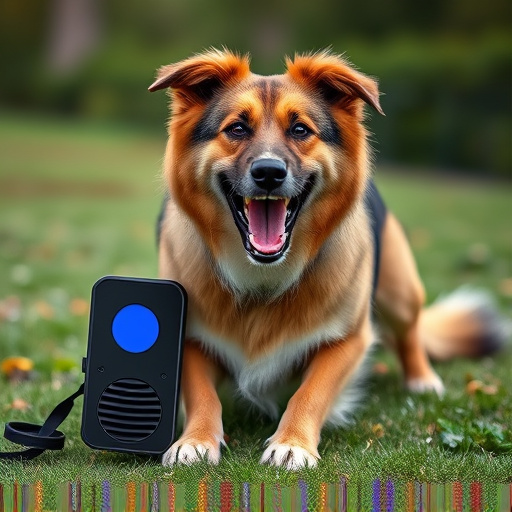Understanding canine behavior is key in addressing excessive barking. Electronic bark deterrents, with shock-resistant construction, offer a humane training tool using specific sounds and vibrations to correct unwanted barking. These devices, adjustable for sensitivity, promote alternative responses by associating certain behaviors with unpleasant stimuli, benefiting the dog's well-being. When selecting a deterrent, prioritize waterproofing, durability, battery life, easy operation, multiple training modes, and quality certifications. Responsible usage alongside consistent training is crucial for modifying behavior using these effective yet safe tools.
“Curious about effective bark prevention solutions? Discover the world of electronic handheld devices designed to address excessive dog barking. In today’s guide, we explore the science behind these tools and how they can help manage canine behavior. From understanding dog psychology to selecting the right device with essential shock-resistant features, you’ll learn training tips for safe and successful implementation. Optimize your pet’s environment and peace of mind.”
- Understanding Dog Behavior: Why Bark Prevention is Necessary
- The Technology Behind Electronic Handheld Bark Deterrents
- Features to Look for in a Shock-Resistant Dog Deterrent Device
- Training and Safety Considerations for Effective Use of the Device
Understanding Dog Behavior: Why Bark Prevention is Necessary
Understanding dog behavior is key to effective bark prevention. Dogs bark for a variety of reasons, from territorial alerts to attention-seeking or even fear and anxiety. What may seem like excessive barking to humans could be a perfectly normal response to their environment for a canine. That’s where electronic bark deterrents step in as a training tool. These handheld devices utilize specific sounds and vibrations to gently correct unwanted barking without causing harm, ensuring the device is built with shock-resistant features for durability and safety. By associating certain actions or behaviors with unpleasant yet non-lethal stimuli, owners can teach their pets alternative responses, ultimately reducing problematic barking.
The need for bark prevention isn’t just about maintaining peace in shared living spaces; it’s also crucial for the well-being of the dog. Repeated barking can be a sign of stress or discomfort, and traditional punishment methods can exacerbate these issues. Electronic deterrents provide a humane alternative, addressing the behavior at its root without resorting to fear-based training. Moreover, features like adjustable sensitivity settings allow for customization based on the individual dog’s needs and responses, making them versatile tools in effective bark management.
The Technology Behind Electronic Handheld Bark Deterrents
The technology behind electronic handheld bark deterrents involves a combination of sophisticated electronics and smart design. These devices emit specific frequencies or sounds that are unpleasant to dogs, effectively stopping unwanted barking without causing harm. The shock-resistant feature is a significant advancement in dog deterrent technology, ensuring the device can withstand the rough handling often experienced during training sessions or outdoor adventures with pets.
This resilience is achieved through robust materials and careful engineering, allowing the bark deterrent to operate reliably even in challenging conditions. Dog owners benefit from this durability as it means the device can be used consistently without fear of damage, enhancing its effectiveness over time. Additionally, shock resistance ensures the safety of both the user and the dog, eliminating concerns about electrical shocks or other hazards that might arise with less robust designs.
Features to Look for in a Shock-Resistant Dog Deterrent Device
When choosing a shock-resistant dog deterrent device, look for key features that ensure both effectiveness and safety. One crucial aspect is waterproofing to protect against elements like rain or snow, which can impact performance. Additionally, durability is essential; the device should withstand rough handling and outdoor conditions. A long battery life is another important consideration, as it means less frequent charging and ensures consistent protection for your dog.
Look for models with adjustable settings to control shock intensity based on your dog’s size and behavior. Easy operation and clear controls are also vital, allowing you to adjust settings quickly and easily. Moreover, consider devices that offer multiple training modes, such as vibration or sound alerts before the shock, giving your dog a chance to respond before activation. Lastly, check for any certifications or guarantees that assure quality and performance.
Training and Safety Considerations for Effective Use of the Device
Training and safety are paramount when introducing an electronic bark prevention device into your dog’s life. Before using the device, it’s crucial to familiarize yourself with its settings and controls. Start by teaching your dog simple commands like “quiet” or “stop barking” using positive reinforcement techniques. Once they understand these cues, gradually introduce the device, starting at a low intensity level. Always ensure the device is used responsibly and ethically, never causing physical harm or distress.
Look for devices designed with shock-resistant features, as this ensures durability during use, especially in active outdoor environments. These features are vital to prevent accidental activation by your dog’s movements, minimizing potential discomfort while maintaining effectiveness. Remember, consistent training alongside responsible device usage will yield the best results in modifying unwanted barking behavior.
When considering a shock-resistant dog deterrent device, understanding both the technology and your dog’s behavior is key to effective training. Look for features that cater to safety and convenience, ensuring the device is durable enough to withstand active dogs. Remember, responsible use involves positive reinforcement alongside deterrence, fostering a harmonious relationship with your pet. By combining these practices with the right tools, you can effectively manage unwanted barking while prioritizing your dog’s well-being.
